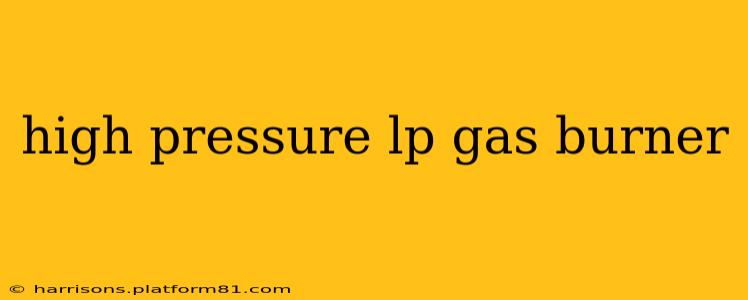High-pressure LP gas burners are efficient and powerful heating solutions used in various industrial and commercial applications. Understanding their intricacies is crucial for safe and effective operation. This comprehensive guide delves into the key aspects of high-pressure LP gas burners, addressing common questions and concerns.
What are the advantages of using high-pressure LP gas burners?
High-pressure LP gas burners offer several advantages over low-pressure systems. Their most significant benefit is their ability to achieve higher heat output and faster heating rates. This is due to the increased gas velocity and better mixing with air, leading to more complete combustion. Furthermore, they often boast greater efficiency, minimizing fuel waste and reducing operating costs. The compact design of many high-pressure burners also contributes to their popularity, saving space in applications where footprint is a consideration. Finally, high-pressure systems are often easier to regulate and control, allowing for precise temperature adjustments.
What are the different types of high-pressure LP gas burners?
Several types of high-pressure LP gas burners cater to diverse needs. These include:
- Atmospheric Burners: These burners rely on ambient air for combustion, offering a simple and cost-effective solution. However, they may be less efficient than other types.
- Forced-Draft Burners: These utilize a blower to supply combustion air under pressure, resulting in improved combustion efficiency and control over flame characteristics.
- Premixed Burners: In premixed burners, the gas and air are thoroughly mixed before entering the combustion chamber, ensuring optimal combustion and minimizing pollutant emissions. These are often preferred for applications requiring precise temperature control and clean burning.
The specific type of burner best suited for a particular application will depend on factors such as the required heat output, desired efficiency, and environmental considerations.
How does a high-pressure LP gas burner work?
High-pressure LP gas burners operate by using a regulated high-pressure gas supply to create a highly turbulent gas stream. This stream is then mixed with air (either atmospherically or through forced draft), creating a highly combustible mixture. The ignition system initiates combustion, producing a powerful and controlled flame. The burner design, including the size and shape of the nozzle and mixing chamber, significantly impacts the flame characteristics and overall efficiency.
What safety precautions should be taken when using high-pressure LP gas burners?
Safety is paramount when working with high-pressure LP gas systems. Always follow manufacturer's instructions meticulously. Regular inspection and maintenance are crucial to prevent leaks and malfunctions. Proper ventilation is essential to remove combustion byproducts and prevent the buildup of potentially dangerous gases. Never operate a burner without proper training and always ensure that appropriate safety equipment, such as eye protection and heat-resistant gloves, is worn.
What are the common applications of high-pressure LP gas burners?
High-pressure LP gas burners find wide application across several industries, including:
- Industrial Heating: Furnaces, kilns, ovens, and various other industrial heating processes benefit from the high heat output and efficiency of these burners.
- Commercial Cooking: High-output cooking equipment such as large ovens and griddles often utilize high-pressure LP gas burners.
- Water Heating: High-pressure burners can provide efficient and rapid water heating for industrial and commercial applications.
How do I maintain a high-pressure LP gas burner?
Regular maintenance ensures optimal performance and safety. This includes:
- Regular inspections: Check for leaks, damage, and signs of wear and tear.
- Cleaning: Remove any debris or buildup that may impede airflow or combustion.
- Component replacement: Replace worn or damaged components as needed.
Following these guidelines will significantly extend the lifespan of your burner and prevent potential problems. Remember, always consult the manufacturer's instructions for specific maintenance procedures.
This guide provides a comprehensive overview of high-pressure LP gas burners. For specific applications and detailed information, always consult with qualified professionals and refer to the manufacturer's specifications. Remember, safety is paramount when working with high-pressure gas systems.
